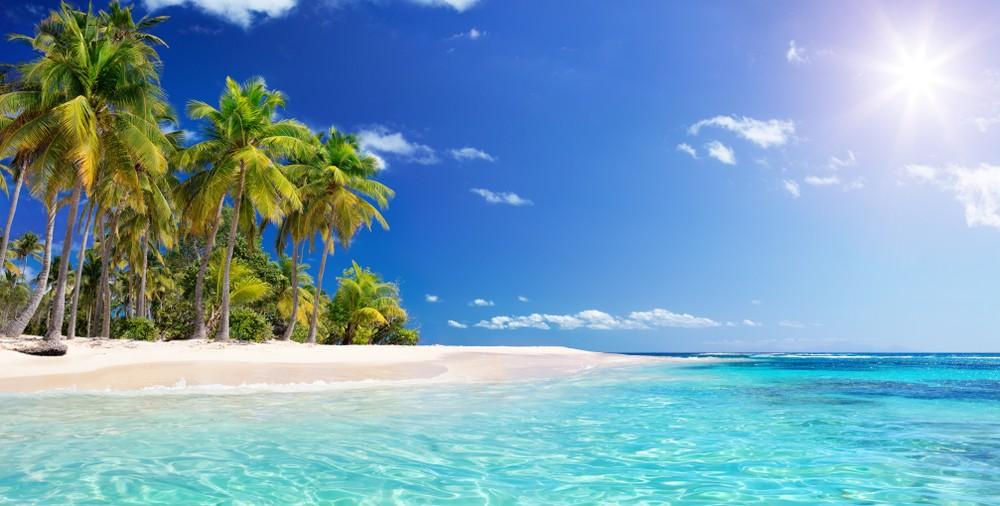For many people, the Caribbean is the longing destination par excellence. White sandy beaches, sprawling palm trees, pure sun and an attitude to life dominated by freedom, good humour and music characterise our picture. Whether you’re traveling to the Caribbean individually, traveling there as part of a cruise or booking an all-inclusive vacation, relaxation is guaranteed. Because as soon as you get off the plane, you have arrived in another world and the attitude to life of the Latinos is so contagious that it captivates everyone.
A brief overview
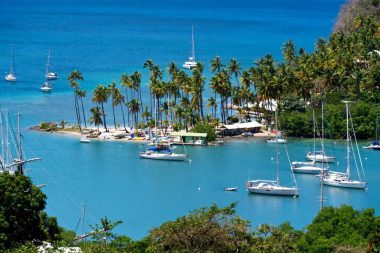
The Caribbean refers to the islands in the tropical part of the western Atlantic. All islands are located north of the equator. Overall, the Caribbean stretches from Florida in the north to Venezuela in the south. The entire Caribbean has an area of 2,754,000 square kilometers and a population of almost 40 million people.
The Caribbean is divided into the Western Caribbean, the Southern Caribbean, the islands in the open Atlantic North, the islands in the open Atlantic South, the Greater Antilles, the Lesser Antilles.
The Lesser Antilles , on the other hand, are divided into the “Leeward Islands” and the “Leeward Islands”. The Greater Antilles include the Dominican Republic, Haiti, Jamaica or Cuba. Leeward Islands include Aruba, Bonaire , and Curacao (ABC Islands). And the Leeward Islands include St. Lucia, Barbados, Guadeloupe, St. Marteen, Antigua and Barbuda and Grenada.
The most popular holiday islands are the Dominican Republic, the Bahamas, Trinidad & Tobago, St. Marteen and Cuba. Cuba is the largest of the Caribbean islands in terms of area.
The best time to travel to the Caribbean
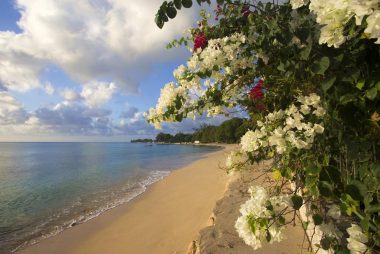
Since the Caribbean stretches over several thousand kilometers, there are different recommendations for different islands when it comes to travel time. In principle, it is best in our European winter in the Caribbean. And that’s a perfect exchange: escape the cold and snow and enjoy the sun and Caribbean flair. But here is an overview of the recommendations for travel time:
- Cuba: The best time to travel to Cuba is from November to April. This leaves the rainy season and hurricane season behind and has pleasant temperatures and more pleasant humidity in the dry season. Nevertheless, due to its location, it is always relatively humid and warm in Cuba and the humidity rarely drops below 80 percent.
- The Bahamas: A trip to the Bahamas is best from December to May. During the day it has a pleasant 25 to 29 degrees Celsius and it is dry. Due to the warm Gulf Stream, the water temperatures are very very pleasant.
- Grenada: For Grenada , the recommendation for travel time is similar, but the best time there starts in January, but also extends into May.
- Cruises: At the same time, the recommendation for a cruise in the Caribbean also falls. However, this is of course still somewhat dependent on the specific goal.
- Trinidad and Tobago: Trinidad and Tobago in the north of the Caribbean off the coast of Venezuela is usually outside the hurricane zone, but should only be visited between January and May due to the rainy season.
- St.Marteen: For St. Marteen (Leeward Islands), the recommended travel time is from January to April.
- ABC Islands: A destination for the whole year are the ABC Islands (Aruba, Bonaire and Curacao). There it has eight to nine hours of sunshine per day all year round. And even if there is a short rain shower, it doesn’t dampen the holiday joy.
Of course, you can also travel to the Caribbean outside the recommended travel times, but the weather is much wetter in the rainy season and the sky is cloudy rather than bright blue. If you are planning to travel to the Caribbean during hurricane season, please pay special attention to the regional warnings so that your holiday enjoyment is not dampened.
Things to do in the Caribbean
If you travel to the Caribbean, you have many opportunities to do something. If you want, you can just let your mind wander and do nothing: relax on the beach all day, enjoy delicious cocktails in a beach bar in the afternoon and just enjoy life. But even those who want to be active can experience a lot.
Sport and exercise
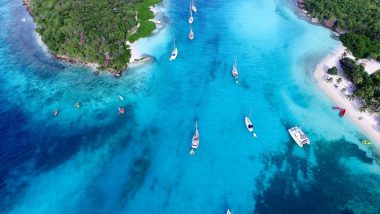
If you like water sports, you can go swimming and diving in many places. The Caribbean is home to many interesting spots for snorkeling and diving. And Belize has the second largest barrier reef in the world. Or you can try windsurfing or kitesurfing and feel the power of wind and water. Plus, you can make the catch of a lifetime deep sea fishing or take off flyboarding. And there are also sports opportunities away from the water. Because some of the islands, for example Puerto Rico, are mountainous and invite you to hike. The volcanoes can be explored on an extensive hike – for example on the island of Dominica.
Cities and culture
If you are interested in culture, you can go on a discovery tour in ancient Mayan sites in countries such as Belize, Mexico or Guatemala and immerse yourself in times long past. And Cuba also offers a lot of activities and wonderful photo opportunities for those interested in culture. Many Caribbean cities are characterized by the style of the colonial era and impress with magnificent restored buildings and mighty colorful cathedrals from this time. In many cities there are also colorful markets where you can stock up on fresh fruit. Or you can stock up on souvenirs and take a little piece of the Caribbean home with you.
Flora and fauna
And if you are interested in foreign flora and fauna, the Caribbean is the right place for you. Because there are many animals and plants to marvel at in numerous national parks that do not exist in Europe. The Dominican Republic alone has over 100 national parks and invites you to dive into the Caribbean jungle.
Culinary delights from the Caribbean: A journey of discovery through the flavors of the islands
The Caribbean is not only known for its beautiful beaches and crystal clear waters, but also for its diverse and tasty cuisine. The culinary landscape of this region is as colorful and diverse as the culture, which has been shaped by the different peoples and their history. The Caribbean includes many different islands, each with its own culinary traditions, but a common denominator is the use of fresh, local ingredients and the combination of flavors from Europe, Africa, India and the indigenous people.
Influences on Caribbean cuisine
The cuisine of the Caribbean is a result of the region’s history, which is marked by the colonial past, slavery and migration of different peoples. Originally influenced by the indigenous Taino, Arawak and Cariben, African, European and Asian influences were later added. This mix of traditions has given rise to a distinctive culinary identity.
- African influences: Many spices and preparation methods come from African cuisine, especially the use of beef, chicken and fish, but also the famous “one-pot” cooking, in which all ingredients are cooked in one pot.
- European influences: The Spanish, French and British colonial rulers brought new ingredients and cooking techniques with them. This is evident in dishes such as ragoûts (stews) and croquettes (meatballs).
- Asian influences: The immigration of Chinese and Indian workers brought spices such as curry, ginger, and garlic to the region, leading to the emergence of dishes such as the popular curry chicken.
- Indigenous influences: The indigenous peoples of the Caribbean used ingredients such as cassava, yams, sweet potatoes and corn. These are still used in many dishes today.
The most important ingredients of Caribbean cuisine
Caribbean cuisine thrives on the fresh, local ingredients that are abundant due to the tropical climate. The most common ingredients include:
- Fish and seafood: Since the Caribbean region is surrounded by oceans, fish and seafood are ubiquitous in the kitchen. Redfish, snapper, crawfish and shrimp are particularly popular.
- Tropical fruits: Mangoes, pineapples, papayas, coconuts and bananas are not only delicious snacks but also essential ingredients in many dishes and drinks.
- Herbs and spices: Caribbean cuisine is known for its intense flavors. These include fresh herbs such as thyme, oregano, parsley and coriander, as well as spices such as ginger, cinnamon, cloves and nutmeg.
- Hot sauces: Pepper and hot sauces made from habaneros, Scotch bonnet or other chili peppers are very common in the Caribbean and give the dishes their distinctive spiciness.
Typical dishes from the Caribbean
Each island in the Caribbean has its own culinary specialties. Here are some typical dishes from different countries:
- Jamaica – Jerk Chicken: Jerk chicken is one of the most famous dishes of the Caribbean. The chicken is marinated with a spice mixture of allspice, cinnamon, nutmeg, ginger and Scotch bonnet chillies and then smoked over an open fire or on the grill. The smoky flavor combined with the spiciness of the spices is unmistakable.
- Trinidad and Tobago – Doubles: Doubles is a popular street food that consists of two soft flatbreads filled with a spicy curry mix of chickpeas. It is often garnished with a spicy tamarind sauce and fresh herbs.
- Haiti – Griot: Griot is a traditional Haitian dish made from marinated pork fried in oil until crispy on the outside and tender on the inside. It’s often served with rice and beans, as well as savory sauces.
- Dominican Republic – Mangu: Mangu is a dish made from pureed green plantains that is often eaten for breakfast. It is served with fried onions, cheese and egg and is a typical example of the local use of bananas.
- Cuba – Ropa Vieja: Ropa Vieja is a classic Cuban dish made from tender, braised beef prepared in tomato sauce with peppers, onions, garlic and cumin. It is often served with rice and black beans.
- Barbados – Flying Fish and Cou Cou: The national dish of Barbados consists of grilled or fried flying fish served with cou cou, a porridge made from cornmeal and okra. It is a simple but tasty dish that reflects the essence of Caribbean cuisine.
Caribbean Drinks
The Caribbean is also famous for its tropical drinks, both alcoholic and non-alcoholic. Among the best known are:
- Rum: Rum is probably the most famous alcoholic drink from the Caribbean. In countries such as Cuba, Jamaica and Barbados, many different types of rum are produced, which are enjoyed both neat and in cocktails such as the Mojito, Piña Colada or Daiquiri.
- Caribbean Sorrel: Sorrel is a drink made from hibiscus flowers that is especially popular at Christmas. It is prepared with sugar, ginger and spices such as cinnamon and cloves.
- Tropical juices: Fresh juices made from mangoes, papayas, pineapples or guavas are widely available in the Caribbean and are a refreshing refreshment on hot days.
Cruise itineraries and ports in the Caribbean: A paradise at sea
The Caribbean is one of the most popular cruise destinations in the world, and for good reason: the crystal clear waters, tropical islands, diversity of cultures, and countless activities on board make Caribbean cruises an unforgettable experience. In this article, we’ll take an in-depth look at the Caribbean’s most popular cruise itineraries and ports, as well as special experiences that await passengers on board and ashore.
The most popular cruise itineraries in the Caribbean
The Caribbean offers a wide range of cruise itineraries, departing from various port cities in the United States, Mexico, and Central America. Depending on the duration of the trip and interests, holidaymakers can choose between short 3- to 4-day trips and longer, multi-week tours. Here are some of the most popular routes:
1. Western Caribbean
The Western Caribbean is known for its impressive islands, white sandy beaches and cultural highlights. This route usually goes to ports in Mexico, Jamaica, the Cayman Islands, and Belize.
- Ports:
- Cozumel (Mexico): Cozumel is a popular destination for divers and snorkelers, thanks to its colorful coral reefs. The island also offers a mix of Mayan ruins, beaches, and lively towns.
- Montego Bay (Jamaica): Here, cruise ship passengers experience the Caribbean joie de vivre to the fullest. Popular excursions include Dunn’s River Falls and visits to plantations and rum factories.
- George Town (Cayman Islands): The Cayman Islands are known for their stunning beaches and clear waters. Snorkeling and diving trips are particularly popular here, as well as boat trips to the famous Stingray City.
2. Eastern Caribbean
The Eastern Caribbean offers some of the region’s best-known islands, including the Bahamas, Puerto Rico, St. Thomas, and the Virgin Islands.
- Ports:
- Nassau (Bahamas): Nassau on New Providence is an exotic paradise that offers both history and luxury. A visit to the Atlantis Resort and the famous Straw Market is a must.
- San Juan (Puerto Rico): The capital of Puerto Rico is a UNESCO World Heritage Site, known for its colonial architecture, the old fortress El Morro and the historic old town.
- Charlotte Amalie (St. Thomas, US Virgin Islands): St. Thomas is known for its perfect shopping and stunning beaches. Diving and snorkeling trips as well as boat trips to secluded bays are particularly popular here.
3. Southern Caribbean
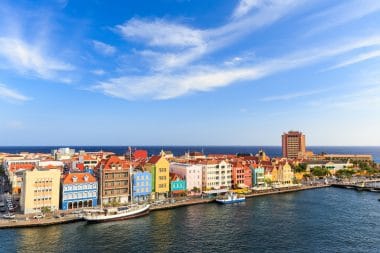
The Southern Caribbean offers a more remote, less-visited side of the region, with less touristy hustle and bustle and breathtaking landscapes.
- Ports:
- Oranjestad (Aruba): Aruba is famous for its white sandy beaches, crystal clear waters, and dry climate. Particularly well-known are the beaches of Palm Beach and Eagle Beach, which are ideal for relaxation and water activities.
- Willemstad (Curaçao): The Dutch Caribbean island of Curaçao enchants with its colorful architecture, coral reefs and multicultural heritage. A highlight is a visit to the Christoffel National Park.
- Kralendijk (Bonaire): Bonaire is a paradise for nature lovers and divers. The island offers some of the best diving in the Caribbean, as well as pristine beaches and abundant birdlife.
Ports in the Caribbean: More than just a port of call
The ports in the Caribbean are not only access points to the islands, but also highlights in their own right, offering travelers fascinating experiences. Many cruise ports have modernized their infrastructure in recent years to offer guests an even better experience. Some of the most famous and popular ports are:
- Labadee (Haiti): A private Royal Caribbean port that offers passengers exclusive access to a tropical paradise. Labadee is known for its white sand beaches, zip-lining across the ocean, and the chance to swim and snorkel in the clear waters.
- CocoCay (Bahamas): Another private island port operated by Royal Caribbean. CocoCay offers a variety of activities, from a water park with waterslides to private cabanas and glass-bottom boat excursions.
- Half Moon Cay (Bahamas): An idyllic, unspoiled paradise offered exclusively to passengers by Holland America Line. Here, guests can relax on pristine beaches or swim in the blue lagoon.
Special experiences on board Caribbean cruises
A Caribbean cruise offers many exciting experiences not only on land, but also on board. Here are some highlights that await passengers on a cruise through the Caribbean:
1. Luxurious Facilities and Entertainment
Modern cruise ships offer a variety of leisure options. Many ships have luxurious spas, gyms, pools, and Jacuzzi areas where guests can relax and rejuvenate. Entertainment is provided by Broadway-like shows, comedy performances, live music, casinos and even ice rinks or surf simulators. Some shipping companies even offer special theme nights and parties that take up the Caribbean theme.
2. Gastronomic highlights
The cuisine on board Caribbean cruise ships is as diverse as the region itself. Cruise lines offer an extensive culinary offer, from all-you-can-eat buffets to fine dining restaurants and specialty restaurants with Caribbean and international dishes. There are also often theme evenings on board that focus on Caribbean dishes.
3. Water sports and adventure on board
For the more adventurous, many cruise ships offer a range of activities, including waterslides, climbing walls, zip-lining, or even kart race tracks on the ship. Diving or snorkeling trips are also frequently offered, and some ships even have their own “platforms” for divers that lead directly into the Caribbean waters.
4. Recreation and wellness
For those seeking relaxation, Caribbean cruises offer plenty of wellness options, including massages, yoga classes, beauty treatments, and steam rooms. Many cruise ships have a spa area overlooking the sea, which allows guests to pamper themselves in a dreamy setting.
5. Exclusive shore excursions
Special excursions are offered at each port, allowing passengers to experience the islands of the Caribbean at their best. From private beach days to safari tours in pristine rainforests to cultural and history tours, these excursions offer unique insights into life on the islands.
Six official languages and exciting religions
In addition to many unofficial languages of the local population, there are six official languages in the Caribbean. Spanish is the most widely spoken language and the official language of Puerto Rico, Cuba and the Dominican Republic. The other languages are English, French, Dutch, Haitian and Papiamento. Papiamento is a creole language spoken on the ABC Islands. When it comes to religions, there are also very different faiths among the more than 40 million inhabitants of the Caribbean.
The majority of this is attributable to Christianity. And other well-known religions such as Hinduism, Buddhism or Judaism are also represented. But what is really exciting are the rather unusual and sometimes spiritual beliefs. Voodoo is one of the best known. The syncretic religion often exists parallel to Christianity or is practiced additionally. In addition to a lot of witchcraft and sorcery, voodoo also stands for the healing power of plants. Especially in Cuba, many people live out the Santería faith. This is a faith imported by African slaves and mixed with Catholic veneration of saints. This rather unknown religion is opposed by the well-known religion of the Rastafarian movement. It was created in the 1930s in the course of the Black Power movement in Kingston, Jamaica. It owes its fame to the famous representative Bob Marley, who sang against racism and slavery. Characteristic external feature are the dreadlocks. They serve as a symbol of pride in the homeland of Africa.
Exotic plants and rare animals
The landscape and underwater world of the Caribbean are just as diverse as the inhabitants. If you are on holiday here and are looking for a change from the white sandy beach and palm trees in between, you will find all kinds of alternatives. Beautiful rainforests entice with lush greenery. Impressive waterfalls, fascinating mountain landscapes and extinct volcanoes satisfy the thirst for adventure. Cuba’s mountain forests are home to many different species of orchids. Sap-rich plants such as frangipani trees, mangroves and ball cacti enrich the natural landscape of the Lesser Antilles and on the ABC Islands, the bizarre Divi-Divi trees sometimes grow directly on the beach. Culinary highlights are provided, for example, by the guava tree, the mango tree, the olive tree or the avocado tree.
In numerous botanical gardens, there is a colourful floral picture of heliconias, bromeliads, flamboyant and many other types of flowers. With over 14000 plants, this diversity of Caribbean flora is not surprising. In the Caribbean wildlife, birds are strongly represented with more than 700 species. The parrot species Blue-headed and Imperial Amazon are only found in Dominica. The latter even has the status of national bird and is threatened with extinction. Wedge-tailed plovers are especially found on St. Martin and Aruba is associated with the flamingo. But it is not only special bird species that fascinate animal lovers. Caribbean manatees are among the rarest animal species in the world. The Caribbean manatees are protected. An encounter with iguanas, crocodiles, bats, the famous Bahamas pigs or sea turtles is also possible.
The history and colorful culture of the Caribbean
The first settlement of the Caribbean took place in 3500 BC. They were Indians from Venezuela. The friendly Arawak Indians were added as a second people. This was followed by the warlike Indians of the Cariben tribe, who ultimately gave the popular holiday region its name. Columbus discovered some Caribbean islands between 1492 and 1504. Further settlement took place through oppression and slavery. In the 16th century, the colonial era began with the arrival of the English. The French and Dutch conquered some of the colonies a short time later and with the arrival of the Africans in 1794, slavery was banned. However, Napoleon reintroduced it in 1802 before Victor Schoelcher banned it again in 1848 and thus the first independence movements began. Workers from China and India were now hired to work on the sugar cane and tobacco plantations.
Their colonial past is still strongly evident in today’s Caribbean. The story is of course less beautiful, especially because of slavery. Nevertheless, this difficult time has also contributed to the fact that today the diverse and cheerful culture makes the region so unique. Each Caribbean island has its own cultural mix. A very important part of Caribbean culture is music. While the Afro-Caribbean music style calypso is mainly found in Barbados and Trinidad and Tobago, Jamaica is the cradle of reggae. An important cultural event is the Carnival of Limón. The entire Limónensa community participates in this festival of music, dance and masquerades of the most diverse kinds. Many tourists also do not miss this annual spectacle in the week around 12 October. The typical Caribbean cuisine also reflects the multicultural diversity. Through the colonial period, Indian cuisine mixed with European influences. Later, Indian components were added and typical foods of African cuisine such as plantains, cassava or sweet potatoes are also used.
Travel budget and cost planning for a Caribbean trip: What you should know
The Caribbean is a dream destination for many travelers, but before you pack your bags, it’s important to create a realistic cost plan for your trip. Prices vary depending on the island, travel time, and type of accommodation, but with a little planning, you can tailor your Caribbean trip to your budget. Here are some key factors that affect costs and tips on how to create a realistic travel budget:
1. Flights
Flights to the Caribbean can vary greatly, depending on the time of travel, the choice of airport and the departure region. Direct flights from major European or North American cities such as New York, London or Miami are often cheaper than flights with stopovers. The high season (December to April) is more expensive, while the low season (May to November) often offers better deals.
- Price range: Direct flights from the US can cost from around $200-500 (for one-way round-trips), while flights from Europe can range from €500 to €1000, depending on the destination and booking period.
2. Accommodation
The Caribbean offers a wide range of accommodations, from all-inclusive resorts to luxurious hotels to budget guesthouses and vacation rentals. The choice of accommodation often depends on your travel style and budget.
- Budget options: Budget accommodations like guesthouses and Airbnbs start at around $50-100 per night. These are suitable for travelers looking for simple but comfortable places to stay.
- Mid-range: Hotels or smaller resorts in the mid-range cost around $100-250 per night.
- Luxury: Five-star resorts and exclusive all-inclusive hotels in the Caribbean can cost anywhere from $300 to $800 per night, although these rates can be even higher in high season.
3. Catering
Food and drink can also vary depending on the destination and type of accommodation. If you’re staying at an all-inclusive resort, most meals are included in the price. In other cases, you should count on meals in restaurants.
- Restaurant dining: A simple lunch at a local restaurant costs around $10-20 per person. A dinner at a fine dining restaurant can cost anywhere from $30-50 per person.
- Self-catering: If you are staying in an apartment or guesthouse with a kitchenette, you can save money by visiting local markets or supermarkets and cooking for yourself. Prices for fresh produce vary by island, but are usually cheaper than restaurant visits.
4. Activities and excursions
The Caribbean offers a variety of activities, from water sports to cultural tours and nature experiences. Prices for excursions may vary depending on the destination and provider.
- Diving and snorkeling tours: These usually cost between $50 and $150 per person, depending on the duration and destination.
- Boat trips and whale watching: A half-day boat trip can cost around $50-100.
- Attraction entrance fees: Many museums or national parks charge entrance fees ranging from $5 to $20.
Family-friendly destinations in the Caribbean
The Caribbean is a wonderful destination for family vacationers, with many kid-friendly hotels, resorts, and activities designed specifically to meet the needs of families. Here are some of the best family-friendly destinations:
1. Bahamas
The Bahamas is known for its stunning beaches and family-friendly resorts. The island of Nassau is particularly recommended, which offers cultural attractions such as the Ardastra Gardens Zoo as well as child-friendly beaches. Many resorts offer kids’ clubs, children’s pools, and special excursions, such as boat tours to see Exuma’s famous pigs.
2. Jamaica
Jamaica is also a very popular destination for families. At hotels and resorts like the Beaches Negril , you’ll find activities and facilities specially tailored for children, including waterslides, childcare, and special kids’ menus. Trips to the famous Dunn’s River Falls, where children as young as 6 years old can also climb, are another highlight.
3. Cayman Islands
The Cayman Islands are known for their beautiful beaches and safe waters that are ideal for snorkeling and swimming. The Stingray City excursion, where you can swim with rays, is a particularly child-friendly activity. The island also offers numerous family-friendly resorts with child-friendly amenities and pools.
4. Punta Cana (Dominican Republic)
Punta Cana is one of the most popular destinations for families in the Caribbean, especially because of its numerous all-inclusive resorts. These offer extensive childcare programs, pools with water slides, and amusement parks. The nearby Manati Park offers the opportunity to swim with dolphins and learn more about the local flora and fauna.
Practical travel tips and preparations for a Caribbean trip
A Caribbean trip requires some preparation to make sure everything goes smoothly. Here are some practical tips to help you plan:
1. Travel insurance
It is advisable to take out comprehensive travel insurance that covers both medical emergencies and travel interruptions or cancellations. Because some Caribbean islands are remote, medical facilities may be limited, and insurance will give you extra peace of mind.
2. Travel documents and visas
For most Caribbean islands, German citizens do not need a visa stay for tourist stays of up to 90 days. However, it is recommended to check the specific entry requirements for your destination, as they may differ depending on the island and country of origin. Make sure your passport is valid for at least 6 months beyond the date of return.
3. Vaccinations and health care
Before traveling to the Caribbean, you should make sure that all recommended vaccinations are up to date. These include vaccinations against hepatitis A and B, typhoid fever and vaccinations against flu and COVID-19. In some areas of the Caribbean, there are also mosquitoes that can transmit diseases such as Zika or dengue. Mosquito repellent is therefore an important part of your travel preparation.
4. Best time to travel
The best time to visit the Caribbean is from December to April, when the weather is dry and pleasant. However, this is also the high season, and the prices of accommodation and flights are higher during this time. The low season from May to November is more favorable, but also associated with the risk of tropical storms. If you choose this time, pay attention to the weather forecast and book flexibly.
5. Money and currency
Most Caribbean islands use the US dollar or local currencies, but these are often easily exchangeable for US dollars. In larger cities, there are ATMs and many shops accept credit cards. Still, it’s wise to have some cash in the local currency with you, especially if you’re visiting smaller places or remote areas.


